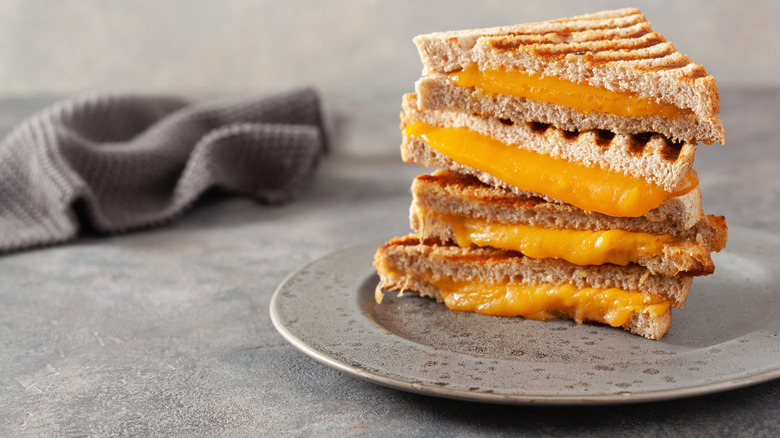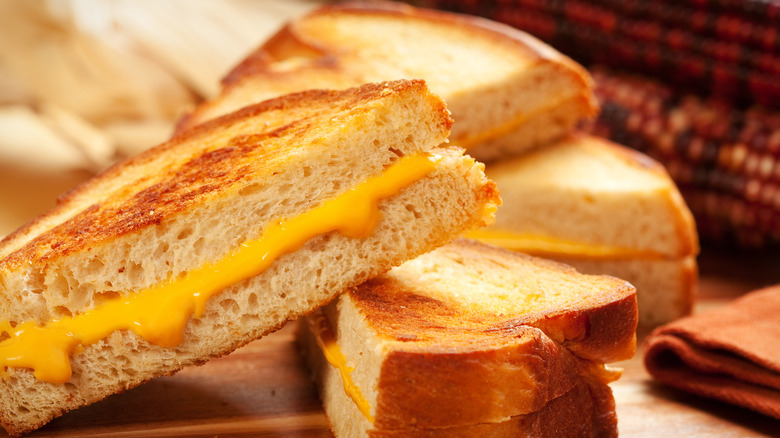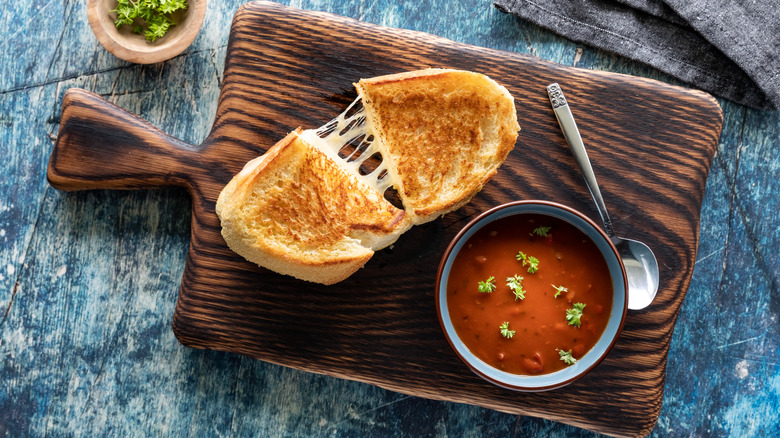How World War II Caused A Spike In Popularity For Grilled Cheese
Who first put cheese between slices of bread and grilled it? We're afraid the name of that genius has been lost to time. Nonetheless, we know how grilled cheese has become so popular — and we're not just talking about its tastiness.
You can't have grilled cheese without the cheese. People discovered cheese more than seven millennia ago, likely while storing milk in a sheep's stomach or while adding salt and/or fruit juice to it (via Forbes). Either way, the dairy curdled and cheese was made. From there, cheesemaking spread around the Mediterranean, arriving in places like Egypt, Mesopotamia, and Stone Age Poland. Later on, the Roman Empire mass-produced the stuff and spread it even farther across the Old World. Cheese then endured through the Dark Ages and finally made its way to America during the 17th century, per the International Dairy Foods Association.
It's around this same time that grilled cheese exploded onto the scene. According to the BBC, the idea of sticking filling between slices of bread for sustenance has existed for millennia. Yet, in the 1700s, John Montagu the Fourth Earl of Sandwich (the English town) apparently inspired the "sandwich" name, after he himself was inspired by Eastern Mediterranean filled pita bread. Now with a moniker, the already popular food concept spread even further, soon earning fame in the New World, as well.
So, how did these two tasty concoctions get sandwiched and grilled together?
Cheesy, toasty dreams
Cheese sandwiches may have been around for as long as cheese was cheese and bread was bread. In fact, per The Takeout, harvesters and shepherds in ancient Mesopotamia ate flatbread with feta as a midday meal out in the field. It's not a terrible stretch of the imagination to think some of those bygone workers put together bread and cheese in a convenient-to-hold way. By the 14th century, melted cheese had become a popular food item, as well, starting with the Welsh (per Culture Trip). Slowly but surely, fate was gradually bringing mouthwatering grilled cheese into existence.
More recent history holds the turning point. Around the early 1900s, according to The Takeout, Canada created the "cheese dream." The savory version of this combined cheese and mustard with buttery, griddled bread (the sweet version put tart jelly on cheese-flavored shortbread). As the savory recipe caught on — thanks to its ingredients' affordability and ubiquity during the Great Depression — people began adding other components, such as bacon, cayenne, eggs, ham, mayonnaise, and tomato sauce (via Farmers' Almanac). The advent of processed cheese further set the stage for what the cheese dream would become; Kraft American cheese kept well, melted easily, and fit perfectly onto square bread. In the 1920s and '30s, more and more people started eating "toasted cheese" for lunch, eventually calling it "grilled cheese" instead. A further spike in popularity would then follow in the 1940s.
Grilled cheese sandwiches
The 1940s were obviously a time of strife. So, while more positive things like the association between classics like tomato soup and grilled cheese recipes helped make the sandwich popular — per The Takeout — it turns out a decidedly negative thing also led to its fame. Kraft Foods had already sold processed cheese in cans to the United States military during the first World War, according to NPR. Therefore, it's not too surprising the U.S. government issued cookbooks promoting grilled cheese while the second global conflict of its kind raged on. Soon enough, grilled cheese was not only a lunchtime staple but a swift and easy option for dinner, too.
Americans weren't the only people relying on cheese during WWII, either. As documented by the Imperial War Museums, the British government also pushed for people to eat more cheese as the global conflict worsened their country's food instability. A public information film from 1940 told moviegoers that cheese can quite easily replace beef, claiming a 5-ounce piece of cheese equals 10 ounces of meat (an impressive ratio). Additionally, it said studies had shown cheese is better than meat for growing children. One way this well-intentioned piece of propaganda suggested consuming that dairy item was in (you guessed it) a grilled cheese sandwich.
Over a long time, bread, cheese, and heat slowly came together. Events both good and bad then transformed grilled cheese into a 20th-century phenomenon. In the new millennium, that sandwich is still a classic.


